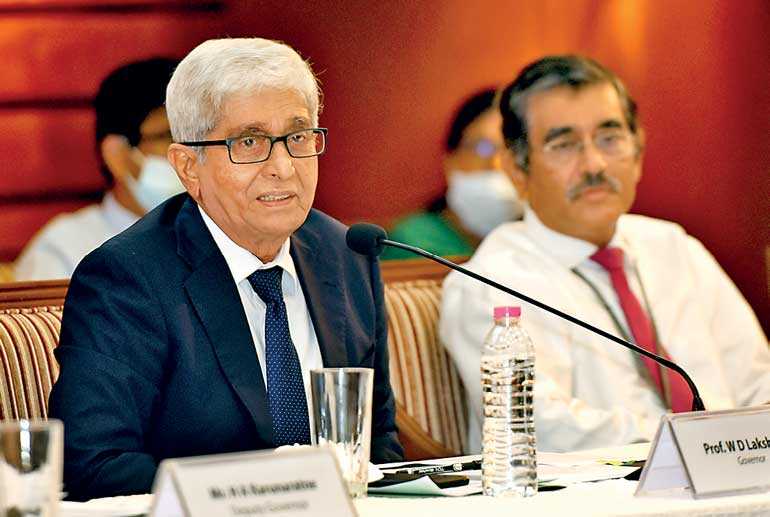Sunday Dec 14, 2025
Sunday Dec 14, 2025
Tuesday, 14 July 2020 00:08 - - {{hitsCtrl.values.hits}}

Central Bank Governor Prof. W.D. Lakshman (left)
By Uditha Jayasinghe
The Central Bank has appointed an internal committee to fast-track reduction of interest rates by banks and encourage them to lend more ahead of reducing rates for the fifth time this week.
Central Bank Governor Prof. W.D. Lakshman on Thursday said that the committee had been established to oversee how well banks take up the task of filtering down the policy changes to the market. So far the monetary authority has reduced policy interest rates by 250 basis points and the Statutory Reserve Ratio (SRR) by 300 basis points.
“There is a committee appointed made up of Central Bank officials to find out what is happening, what prevents them (banks) from extending loans as determined by the Central Bank and why they are not responding adequately to interest rates or giving as much loans as permitted by the improved conditions. The committee is looking into this and in the time to come, with our pressure, there will be some improvement,” the Governor assured.
Senior Deputy Governor Dr. Nandalal Weerasinghe, explaining the reasons as to why relief may be taking time to filter to companies, noted that private sector credit was yet to pick up after the COVID-19 slump and volumes of Small and Medium Enterprises (SMEs) were small in comparison to other segments of the economy. He also said that banks were conscious of recouping their costs and were therefore making careful evaluations.
Highlighting the challenges involved, Central Bank officials said the Non-Performing Loan (NPL) ratio increased to 5.6% in May from 5.1% at the end of March, taking the accumulative figure up to Rs. 481 billion. The numbers could be adjusted further as the Central Bank makes allowances for the COVID-19 moratorium given to businesses.
However, NPL ratios have been trending up over the past two years and were exacerbated by the Easter Sunday attacks. Last year they were hovering at the 4.8% mark for banks and about twice that for finance companies.
The Central Bank also acknowledged they have access to the US Federal Reserves $ 1 billion Repo facility but the Government has not yet made a decision on whether to utilise it, preferring to keep it as a “backstop”.
“The US Government offered the facility for all central banks, especially account holders of the US Federal Reserve. If we have excess liquidity we invest it in a kind of fixed income securities and those become longer-term investments, but if there are liquidity needs the Fed has given us a Repo facility where we can hedge our existing investments and we can get cash instead of liquidating or selling those investments at a loss,” Dr. Weerasinghe told reporters.
“Whenever the Government is not going to bring new money for their debt service payments, we have an obligation to meet those payments out of our reserves. Then we might have liquidity needs going forward, in that situation we have this facility now open. We can use it if necessary, but we have not utilised it yet,” he added.
In an effort to tackle troubled finance companies, the Central Bank has outlined plans to merge smaller companies or if they have the capacity to bring in fresh capital to put the business on a more sustainable footing, said Central Bank Deputy Governor H. A. Karunaratne.
“According to our analysis there are a number of categories; in the lower category the companies can be merged or we can have a consolidation program. They can also bring in fresh capital and we are planning to force some companies to merge, otherwise it will not happen. So those programs are now moving forward.”
While rejecting accusations that the Central Bank had failed to supervise struggling finance companies adequately, Karunaratne noted that the number of entities had reduced from 55 to 41 through recent efforts of the monetary institution.